Gatehouse
Encyclopedia

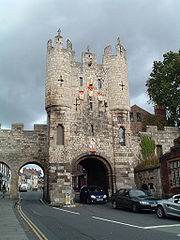
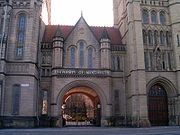
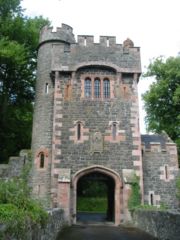
Castle
A castle is a type of fortified structure built in Europe and the Middle East during the Middle Ages by European nobility. Scholars debate the scope of the word castle, but usually consider it to be the private fortified residence of a lord or noble...
, manor house
Manor house
A manor house is a country house that historically formed the administrative centre of a manor, the lowest unit of territorial organisation in the feudal system in Europe. The term is applied to country houses that belonged to the gentry and other grand stately homes...
, fort, town or similar buildings of importance.
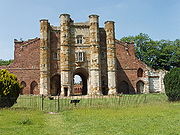

History
Gatehouses made their first appearance in the early antiquity when it became necessary to protect the main entrance to a castle or town. Over time, they evolved into very complicated structures with many lines of defense. Strongly fortified gatehouses would normally include a drawbridge, one or more portcullisPortcullis
A portcullis is a latticed grille made of wood, metal, fibreglass or a combination of the three. Portcullises fortified the entrances to many medieval castles, acting as a last line of defence during time of attack or siege...
es, machicolation
Machicolation
A machicolation is a floor opening between the supporting corbels of a battlement, through which stones, or other objects, could be dropped on attackers at the base of a defensive wall. The design was developed in the Middle Ages when the Norman crusaders returned. A machicolated battlement...
s, arrow loops and possibly even murder-hole
Murder-hole
A murder hole or meurtrière is a hole in the ceiling of a gateway or passageway in a fortification through which the defenders could fire, throw or pour harmful substances, such as rocks, arrows, scalding water, hot sand, quicklime, tar, or boiling oil, down on attackers. They also allowed water to...
s where stones would be dropped on attackers. In some castles, the gatehouse was so strongly fortified it took on the function of a keep
Keep
A keep is a type of fortified tower built within castles during the Middle Ages by European nobility. Scholars have debated the scope of the word keep, but usually consider it to refer to large towers in castles that were fortified residences, used as a refuge of last resort should the rest of the...
, sometimes referred to as a "gate keep". Examples of such gate keeps can be found at Bodiam Castle
Bodiam Castle
Bodiam Castle is a 14th-century moated castle near Robertsbridge in East Sussex, England. It was built in 1385 by Sir Edward Dalyngrigge, a former knight of Edward III, with the permission of Richard II, ostensibly to defend the area against French invasion during the Hundred Years' War...
and Beaumaris Castle
Beaumaris Castle
Beaumaris Castle, located in the town of the same name on the Isle of Anglesey in Wales, was built as part of King Edward I's campaign to conquer the north of Wales. It was designed by James of St. George and was begun in 1295, but never completed...
. In the late Middle Ages, some of these arrow loops might have been converted into gun loops (or gun ports).
Sometimes gatehouses formed part of town fortifications, perhaps defending the passage of a bridge across a river or a moat, as Monnow Bridge
Monnow Bridge
Monnow Bridge in Monmouth, Wales, is the only remaining mediæval fortified river bridge in Great Britain with its gate tower still standing in place. It crosses the River Monnow just above its confluence with the River Wye.- 13th-century bridge :...
in Monmouth
Monmouth
Monmouth is a town in southeast Wales and traditional county town of the historic county of Monmouthshire. It is situated close to the border with England, where the River Monnow meets the River Wye with bridges over both....
. York
York
York is a walled city, situated at the confluence of the Rivers Ouse and Foss in North Yorkshire, England. The city has a rich heritage and has provided the backdrop to major political events throughout much of its two millennia of existence...
has four important gatehouses, known as "Bars", in its city walls
York city walls
The English city of York has, since Roman times, been defended by walls of one form or another. To this day, substantial portions of the walls remain, and York has more miles of intact wall than any other city in England...
. One such is Micklegate
Micklegate
Micklegate is a street in the City of York, England. The name means "Great Street", "Gate" coming from the Old Norse gata, or street. Micklegate lies on the Western side of the River Ouse, Yorkshire, and holds the southern entrance into the city, Micklegate Bar, through which many monarchs have...
Bar.
The French term for gatehouse is logis-porche. This could be a large, complex structure that served both as a gateway and lodging or it could have been composed of a gateway through an enclosing wall. A very large gatehouse might be called a châtelet (small castle).
At the end of the Middle Ages, many gatehouses in England and France were converted into beautiful, grand entrance structures to manor houses or estates. Many of them became a separate feature free-standing or attached to the manor or mansion only by an enclosing wall. By this time the gatehouse had lost its defensive purpose and had become more of a monumental structure designed to harmonize with the manor or mansion.
On the continent of Europe, there are numerous examples of surviving gatehouses in France
France
The French Republic , The French Republic , The French Republic , (commonly known as France , is a unitary semi-presidential republic in Western Europe with several overseas territories and islands located on other continents and in the Indian, Pacific, and Atlantic oceans. Metropolitan France...
, Austria
Austria
Austria , officially the Republic of Austria , is a landlocked country of roughly 8.4 million people in Central Europe. It is bordered by the Czech Republic and Germany to the north, Slovakia and Hungary to the east, Slovenia and Italy to the south, and Switzerland and Liechtenstein to the...
and Germany
Germany
Germany , officially the Federal Republic of Germany , is a federal parliamentary republic in Europe. The country consists of 16 states while the capital and largest city is Berlin. Germany covers an area of 357,021 km2 and has a largely temperate seasonal climate...
.
England
- Ightham MoteIghtham MoteIghtham Mote is a medieval moated manor house close to the village of Ightham, near Sevenoaks in Kent .The name "mote" derives from "moot", "meeting [place]", rather than referring to the body of water....
, in Kent has an imposing 13th and 14th century gatehouse. - Nottingham CastleNottingham CastleNottingham Castle is a castle in Nottingham, England. It is located in a commanding position on a natural promontory known as "'Castle Rock'", with cliffs high to the south and west. In the Middle Ages it was a major royal fortress and occasional royal residence...
, in NottinghamNottinghamNottingham is a city and unitary authority in the East Midlands of England. It is located in the ceremonial county of Nottinghamshire and represents one of eight members of the English Core Cities Group...
has an imposing 11th century gatehouse. - Durham CastleDurham CastleDurham Castle is a Norman castle in the city of Durham, England, which has been wholly occupied since 1840 by University College, Durham. It is open to the general public to visit, but only through guided tours, since it is in use as a working building and is home to over 100 students...
, in DurhamDurhamDurham is a city in north east England. It is within the County Durham local government district, and is the county town of the larger ceremonial county...
has a 11th century gatehouse that is now used as student accommodation for students attending University College, DurhamUniversity College, DurhamUniversity College, commonly known as Castle, is a college of the University of Durham in England. Centred around Durham Castle on Palace Green, it was founded in 1832 and is the oldest of Durham's colleges. As with all of Durham's colleges, it is, independently of the University, a listed body...
. - Stokesay CastleStokesay CastleStokesay Castle is a fortified manor house in Stokesay, a mile south of the town of Craven Arms, in southern Shropshire. It was built in the late 13th century...
, a 13th century fortified manor-house in Shropshire has a Jacobean half-timbered gatehouse. - Stanway Hall, Stanway, GloucestershireStanway, GloucestershireStanway is a small crossroads village in the English county of Gloucestershire, about 1 mile south of Stanton: both villages are on the Cotswold Way...
, where the gatehouse measures 44 ft. by 22 ft. and has three storeys. - Westwood, WorcestershireWorcestershireWorcestershire is a non-metropolitan county, established in antiquity, located in the West Midlands region of England. For Eurostat purposes it is a NUTS 3 region and is one of three counties that comprise the "Herefordshire, Worcestershire and Warwickshire" NUTS 2 region...
, which has a frontage of 54 ft. with two storeys. - Burton Agnes HallBurton Agnes HallBurton Agnes Hall is an Elizabethan manor house in the village of Burton Agnes, near Driffield in Yorkshire. It was built by Sir Henry Griffith in 1601–10 to designs attributed to Robert Smythson...
, YorkshireYorkshireYorkshire is a historic county of northern England and the largest in the United Kingdom. Because of its great size in comparison to other English counties, functions have been increasingly undertaken over time by its subdivisions, which have also been subject to periodic reform...
, which has three storeys and is flanked by great octagonal towers at the angles. - Hylton CastleHylton CastleHylton Castle is a ruined stone castle in the North Hylton area of Sunderland, Tyne and Wear, England. Originally built from wood by the Hilton family shortly after the Norman Conquest in 1066, it was later rebuilt in stone in the late 14th to early 15th century...
, Hylton, SunderlandHylton Castle (suburb)Hylton Castle is a suburb of Sunderland, Tyne and Wear, England. It is named after the nearby Hylton Castle....
, although an actual castle, it is styled in the shape of a classical gatehouse (this is due to the castle being built for comfort as opposed to a castle for defence).
France
- Château de SuscinioChâteau de SuscinioThe Château de Suscinio or de Susinio is a French castle, built in the late Middle Ages, to be the residence of the Dukes of Brittany. It is located near the town of Sarzeau in the département of Morbihan, near the coast of the Atlantic ocean...
, a large 15th century gatehouse in the logis-porte style, Morbihan, Brittany. - Château de TrécessonChâteau de TrécessonThe Château de Trécesson which has preserved its medieval aspect, is one of the most impressive castles of Brittany. It is located in the commune of Campénéac in the Morbihan département of France, near the Paimpont forest and on the edge of the military camp of Coëtquidan...
, a simple 14th century gatehouse on a moated-manor house in Morbihan, Brittany (see French Wikipedia page, Château de Trécesson) - Château de VitréChâteau de VitréThe Château de Vitré is a medieval castle in the town of Vitré, in the Ille-et-Vilaine département of France.The first castle in Vitré was built of wood on a feudal motte around the year 1000 on the Sainte-Croix hill...
, a large 15th century châtelet or gatehouse in Ille-et-Vilaine, Brittany (see French Wikipedia page, Château de Vitré)
United States
- Latrobe GateLatrobe GateThe Latrobe Gate is a historic gatehouse located at the Washington Navy Yard in Southeast Washington, D.C. Built in 1806 and substantially altered in 1881, the ceremonial entrance to the U.S. Navy's oldest shore establishment is an example of Greek Revival and Italianate architecture...
, a Greek RevivalGreek Revival architectureThe Greek Revival was an architectural movement of the late 18th and early 19th centuries, predominantly in Northern Europe and the United States. A product of Hellenism, it may be looked upon as the last phase in the development of Neoclassical architecture...
and ItalianateItalianate architectureThe Italianate style of architecture was a distinct 19th-century phase in the history of Classical architecture. In the Italianate style, the models and architectural vocabulary of 16th-century Italian Renaissance architecture, which had served as inspiration for both Palladianism and...
gatehouse built in 1806, Washington, D.C. - Lorraine Park Cemetery Gate LodgeLorraine Park Cemetery Gate LodgeThe Lorraine Park Cemetery Gate Lodge is a historic gatehouse located near Woodlawn, Baltimore County, Maryland, United States. It is a -story, Queen Anne–style stone-and-frame building designed by Baltimore architect Henry F. Brauns that was constructed in 1884...
, a Queen Anne style stone and frame building constructed in 1884, WoodlawnWoodlawn, MarylandWoodlawn is the name of some places in the U.S. state of Maryland:*Woodlawn, Baltimore County, Maryland*Woodlawn, Prince George's County, Maryland...
, Baltimore County, MarylandBaltimore County, MarylandBaltimore County is a county located in the northern part of the US state of Maryland. In 2010, its population was 805,029. It is part of the Baltimore-Washington Metropolitan Area. Its county seat is Towson. The name of the county was derived from the barony of the Proprietor of the Maryland...
.

